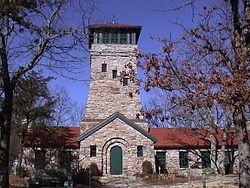






State parks are parks or other protected areas managed at the sub-national level within those nations which use "state" as a political subdivision. State parks are typically established by a state to preserve a location on account of its natural beauty, historic interest, or recreational potential. There are state parks under the administration of the government of each U.S. state, some of the Mexican states, and in Brazil. The term is also used in the Australian states of Victoria and New South Wales. [1] The equivalent term used in Canada, Argentina, South Africa, and Belgium, is provincial park. Similar systems of local government maintained parks exist in other countries, but the terminology varies.
Contents
State parks are thus similar to national parks, but under state rather than federal administration. Similarly, local government entities below state level may maintain parks, e.g., regional parks or county parks. In general, state parks are smaller than national parks, with a few exceptions such as Anza-Borrego Desert State Park in California, Wood-Tikchik State Park in Alaska, or Adirondack State Park in New York, the largest state park in the United States.
In addition to preserving natural landscapes and providing recreational opportunities, many state parks also serve as important educational resources. They often offer guided tours, interpretive programs, and exhibits that help visitors learn about the local flora, fauna, geology, and cultural history of the area. These programs are designed not only to enhance the visitor experience but also to promote conservation awareness and encourage responsible enjoyment of natural resources. [2]
